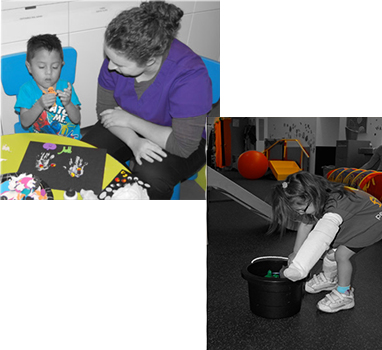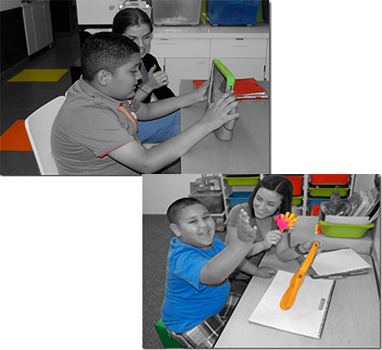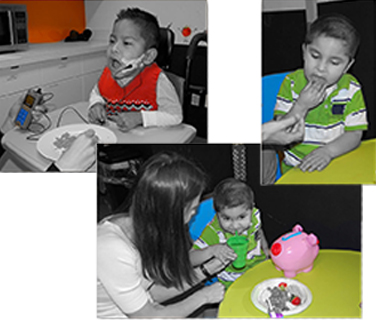

Our Occupational Therapists work with infants and children utilizing therapeutic activities to increase participation in self-care, play and upper extremity activity. Our therapists are licensed to practice in the state of Arizona. Occupational therapy addresses difficulties that children may have with hand writing, sensory processing, behavioral regulation and feeding issues as well. Our Occupational Therapist have many years of experience and strive to provide the highest level of evidence-based practice.
Specialized evaluation and treatment is provided in the following areas:

- Coordination
- Sensory Processing
- Therapeutic Listening
- Fine Motor Skills
- Infant Massage
- Handwriting
- Self-Help Skills
- Adaptive Equipment
- Environmental Adaptations
- Splint Fabrication
- Visual Motor Skills
- Feeding Therapy
- Constraint-Induced Movement Therapy

Our Physical Therapists are highly skilled and trained in the biomechanical assessment and treatment of infants and children. Our therapists have completed their doctorate degree and are licensed to practice in the state of Arizona. Our Physical Therapists regularly attend continuing education courses to further develop their individual expertise. They utilize direct handling and play, in addition to, Bioness, Neuromuscular Electrical Stimulation (NMES), Kinesiotaping, Theratogs, SPIO garments, hip helpers, and other orthotics to provide the highest level of evidence-based practice. Our Physical therapists are also trained and utilize the Litegait for body weight support treadmill training.
Specialized evaluation and treatment is provided in the following areas:

- Aerobic capacity/endurance
- Assistive and adaptive devices
- Circulation (arterial, venous, lymphatic)
- Environmental, home, and work (job/school/play) barriers
- Ergonomics and body mechanics
- Gait, locomotion, and balance
- Joint integrity and mobility
- Motor function (motor control and motor learning)
- Muscle performance (including strength, power, and endurance)
- Orthotic, protective, and supportive devices
- Pain
- Seating and mobility devices
- Posture
- Range of motion (including muscle length)
- Reflex integrity

Our Speech-Language Pathologists evaluate, diagnose and treat speech, language, and feeding/swallowing disorders. Our therapists are licensed to practice in Arizona and maintain national certification by the American Speech-Language and Hearing Association (ASHA). Our therapist utilize the highest levels of evidence-based practice in combination with a family-center approach to achieve each child’s goals.
Specialized evaluation and treatment is provided to
toddlers and children in the following areas:

- Motor Speech Disorders (apraxia, dysarthria, etc.)
- Articulation and Phonology
- Assistive Technology/Augmentative Communication (AAC)
- Auditory Processing Disorders
- Expressive/Receptive Language
- Feeding/Swallowing/Oral Motor Function
- Fluency (stuttering, cluttering, etc.)
- Aural Rehabilitation/Habilitation
- Voice/Resonance
- Problem Solving/Memory/Sequencing
- Pragmatic/Social Communication Skills
- VitalStim for treatment of Dysphagia

In addition to treating speech and language disorders, our Speech Language Pathologists also evaluate and treat children with a variety of feeding and swallowing disorders.
Signs and symptoms of feeding may include:

- Coughing, choking, or gagging during eating
- Wet or gurgly sounding breathing or voice during feeding
- Not eating enough food or refusing foods
- Delay in feeding milestones
- Frequent respiratory infections
Some medical conditions that may cause feeding or swallowing problems in children include prematurity or low birth weight, neuromuscular disorders, autism, cleft lip or palate, developmental delays, food allergies, respiratory problems, GI problems like reflux, history of tube feeding, and others.
Goals of feeding therapy are to:
- Increase safe oral intake of nutrition and hydration
- Decrease refusal behaviors
- Decrease dependence on tube feeding
- Increase or maintain weight
To work toward these goals, the SLP may address:
- Exercises for strength and coordination of the oropharyngeal swallowing system
- Sensory stimulation
- Food exploration
- Positioning/seating
- VitalStim for dysphagia (neuromuscular electrical stimulation for facial or throat muscles)
- Caregiver training
The SLP will also work closely with other medical professionals involved in the care of the child’s feeding problem including GI, pulmonology, neurology, and general pediatricians.

Speech Therapy Evaluations
Why do we recommend bilingual speech evaluations and treatment?
Evaluations:
A bilingual evaluation can determine if a child has a language disorder (i.e. language skills are delayed in both languages) or a language difference (ex. where skills in English have not caught up to skills in Spanish or vice versa). If a primary-speaking Spanish child is only evaluated in English, he might appear to have a language disorder, when he really lacks experience in English. Similarly, if a primary-speaking English child was evaluated in only Spanish, he might appear to have a language disorder as well. Assessment should always be done in the dominant language (whichever language is stronger, both in terms of what they understand and produce). Informal translation of an English test into Spanish should be avoided because it is not testing Spanish language concepts appropriately (and vice versa). Samples should be taken of both languages to see grammar and language concepts in both as well as code-switching (i.e. using English and Spanish in the same sentence).
Treatment:
Kids benefit from bilingual speech therapy because their knowledge of 1 language (Spanish, English, etc.) can help support their learning of their 2nd language (English, Spanish, etc.). Kids may also benefit from help in both languages, making bilingual therapy necessary. The language used in therapy will depend on a variety of factors such as language history (relative experience with each language), use in each language (how frequently the child utilizes each of the languages), proficiency in each language (how well the child understands and produces each language), environment (where and with whom the child uses each language), and family considerations (the family’s goals) (Goldstein, 2006).
Evaluaciones Para la Terapia del Habla
¿Por qué recomendamos evaluaciones del habla bilingues y el tratamiento?
Evaluaciones:
una evaluación bilingue puede determinar si un niño/a tiene un trastorno del lenguaje (es decir, las habilidades linguísticas se retrasan en los dos idiomas) o una diferencia de idioma (por ejemplo, donde las habilidades en Inglés no han alcanzado a las habilidades en español, o viceversa). Si el español es la lengua primaria de su niño/a y sólo se evalúa en Inglés, podría parecer que tienen un trastorno del lenguaje, cuando en realidad carece de experiencia en Inglés. Del mismo modo, si Inglés es la lengua primaria de su niño/a y sólo se evalúa en español, podría parecer que tienen un trastorno del lenguaje también. Evaluación debe hacerse siempre en el idioma dominante (el idioma que es más fuerte, tanto en términos de lo que ellos entienden y producen). Traducción informal de una prueba de Inglés al Español se debe evitar, ya que no está poniendo a prueba conceptos de español apropiadamente (y vice versa). Se deben tomar muestras de ambos idiomas para ver los conceptos de gramática y el lenguaje, tanto así como el cambio de código (es decir, el uso de Inglés y Español en la misma frase).
Tratamiento:
Los niños se benefician de la terapia del habla bilingue, ya que su conocimiento de la lengua primera (Español, Inglés, etc) puede ayudar a apoyar el aprendizaje de su segundo idioma (Inglés, español, etc.) Los niños también pueden beneficiarse de la ayuda en los dos idiomas, por lo que la terapia bilingue es necesaria. El lenguaje utilizado en la terapia dependerá de una variedad de factores como la historia de la lengua (la experiencia en relación con cada idioma), el uso de cada lengua (la frecuencia con que el niño usa cada una de las lenguas), el dominio de cada lengua (qué tan bien el niño/a entiende y produce cada idioma), medio ambiente (dónde y con quién el niño/a usa cada idioma), y las consideraciones de la familia (los objetivos de la familia) (Goldstein, 2006).










